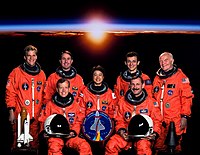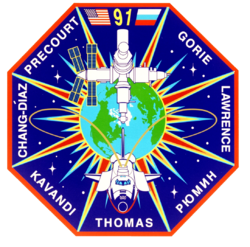STS-95
| Missionsemblem | |||||
|---|---|---|---|---|---|
 | |||||
| Missionsstatistik | |||||
| Missionsnavn: | STS-95 | ||||
| Rumagentur: | NASA | ||||
| Rumfærge: | Discovery (25) | ||||
| Antal besætningsmedlemmer: | 7 | ||||
| Affyringsrampe: | LC-39B (KSC) | ||||
| Opsendelse: | 29. oktober 1998 | ||||
| Landing: | 7. november 1998 | ||||
| Landet på: | Kennedy Space Center | ||||
| Varighed: | 7 dage, 23 timer | ||||
| Foto af besætningen | |||||
 | |||||
| Navigation | |||||
| |||||
STS-95 (Space Transportation System-95) var Discoverys 25. rumfærge-mission. Den blev opsendt d. 29. oktober 1998 og vendte tilbage den d. 7. november 1998.
Den daværende senator og tidligere astronaut John Glenn var i en alder af 77 år med på missionen, han havde sidst været i rummet i 1961 med Mercury-programmet. Glenn var forsøgsperson i ældning i rummet [1].
Besætning

 Curtis Brown (kaptajn)
Curtis Brown (kaptajn)
 Steven Lindsey (pilot)
Steven Lindsey (pilot)
 Pedro Duque (1. missionsspecialist) ESA
Pedro Duque (1. missionsspecialist) ESA
 Scott Parazynski (2. missionsspecialist)
Scott Parazynski (2. missionsspecialist)
 Stephen Robinson (3. missionsspecialist)
Stephen Robinson (3. missionsspecialist)
 Chiaki Mukai (specialist) NASDA
Chiaki Mukai (specialist) NASDA
 John Glenn (specialist)
John Glenn (specialist)
Missionen
Nyttelast
- SPACEHAB-SM
- Spacehap med eksperimenter [4]
- Spartan 201
- Satellit til udforskning af Solens Korona [5]
- The Hubble Space Telescope Orbiting Systems Test (HOST)
- Hubble-rumteleskopet System Test
- The International Extreme Ultraviolet Hitchhiker
- The International Extreme Ultraviolet Hitchhiker (IEH-03) med seks forskellige eksperimenter
- Biological Research in Canisters (BRIC)
- Cryogenic Thermal Storage Unit (CRYOTSU)
- Electronic Nose (E-NOSE)
- Getaway Special (GAS) Program
- Protein Crystal Growth (PCG)
- Space Experiment Module (SEM) – 4
Hovedartikler:
| Wikimedia Commons har medier relateret til: |
Eksterne henvisninger
- STS-95 NASA (engelsk)
- STS-95 NASA KSC (engelsk)
- John Glenn returns to space (Webside ikke længere tilgængelig) Film fra Yahoo (engelsk)
- ^ Veteran vender tilbage til rummet (Webside ikke længere tilgængelig) Ingeniøren
- ^ STS-95 Payloads Arkiveret 3. oktober 2006 hos Wayback Machine (engelsk)
- ^ Aging in space Arkiveret 11. oktober 2008 hos Wayback Machine (engelsk)
- ^ SPACEHAB module flown on STS-95 Arkiveret 15. januar 2011 hos Wayback Machine (engelsk)
- ^ SPARTAN 201: NASA's mission to explore the Sun's corona (engelsk)
| ||||||||
| ||||||||||||||||||||
Medier brugt på denne side
The STS-95 patch, designed by the crew, is intended to reflect the scientific, engineering, and historic elements of the mission. The Space Shuttle Discovery is shown rising over the sunlit Earth limb, representing the global benefits of the mission science and the solar science objectives of the Spartan Satellite. The bold number '7' signifies the seven members of Discovery's crew and also represents a historical link to the original seven Mercury astronauts. The STS-95 crew member John Glenn's first orbital flight is represnted by the Friendship 7 capsule. The rocket plumes symbolize the three major fields of science represented by the mission payloads: microgravity material science, medical research for humans on Earth and in space, and astronomy.
Forfatter/Opretter: Kwamikagami, Licens: CC BY-SA 4.0
symbol of Mars. 16 × 16 pixel nominal dimensions, lines 2 pixel thick, square caps. Colour 75% blue: red=0 green=0 blue=191 (#0000BF).
SVG version of PNG Space Shuttle Logo/Patch.
Designed by the crew members, this patch commemorates the first assembly flight to carry United States-built hardware for constructing the International Space Station (ISS). This flight's primary task is to assemble the cornerstone of the Space Station: the Node with the Functional Cargo Block (fgb). The rising sun symbolizes the dawning of a new era of international cooperation in space and the beginning of a new program: the International Space Station. The Earth scene outlines the countries of the Station Partners: the United States, Russia, those of the European Space Agency (ESA), Japan, and Canada. Along with the Pressurized Mating Adapters (PMA) and the Functional Cargo Block, the Node is shown in the final mated configuration while berthed to the Space Shuttle during the STS-88/2A mission. The Big Dipper Constellation points the way to the North Star, a guiding light for pioneers and explorers for generations. In the words of the crew, "These stars symbolize the efforts of everyone, including all the countries involved in the design and construction of the International Space Station, guiding us into the future."
Five astronauts based at the Johnson Space Center (JSC) and two payload specialists take a break from their training schedule to pose for the STS-95 pre-flight portrait. Seated are astronauts Curtis L. Brown Jr. (right), mission commander; and Steven W. Lindsey, pilot. Standing, from the left, are Scott F. Parazynski and Stephen K. Robinson, both mission specialists; Chiaki Mukai, payload specialist representing Japan's National Space Development Agency (NASDA); Pedro Duque, mission specialist representing the European Space Agency (ESA); and U.S. Sen. John H. Glenn Jr., payload specialist. The seven are scheduled to be launched into Earth orbit aboard the Space Shuttle Discovery in late October of this year.
John Glenn während der STS-95 Mission
STS-91 CREW INSIGNIA (March 1998) --- This is the crew patch for the STS-91 mission -- the ninth flight of the Shuttle-Mir Phase One docking missions. The crew will bring back Andrew S. W. Thomas, the last long-duration American crew member flown on the Russian Space Station Mir. This mission marks the end of the Shuttle-Mir Phase One Program and will open the way for Phase Two: construction of the International Space Station (ISS). The crew patch depicts the rendezvous of the Space Shuttle Discovery with the Space Station Mir. The flags of the United States and Russia are displayed at the top of the patch and both countries are visible on the Earth behind the two spacecraft. The names of the American crew members surround the insignia on the outer areas, with the name of cosmonaut Valery Ryumin in Cyrillic at the lower right. The Alpha Magnetic Spectrometer (AMS) is an international payload planned to fly in the payload bay of Discovery. Two thin golden streams flowing into the AMS represent charged elementary particles. The detection of antimatter in space will help scientists better understand the physics and origins of the universe.
Rotated and color enhanced version of original (ISS013-E-48788 (6 July 2006) --- The Space Shuttle Discovery approaches the International Space Station for docking but before the link-up occurred, the orbiter "posed" for a thorough series of inspection photos. Leonardo Multipurpose Logistics Module can be seen in the shuttle's cargo bay. Discovery docked at the station's Pressurized Mating Adapter 2 at 9:52 a.m. CDT, July 6, 2006.)
STS-95 crewmember, astronaut and U.S. Senator John Glenn. Glenn was the first American to orbit the earth and returned to space in 1998 aboard a Space Shuttle flight.


















